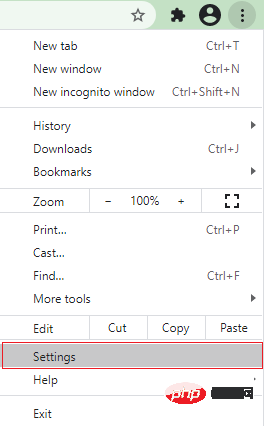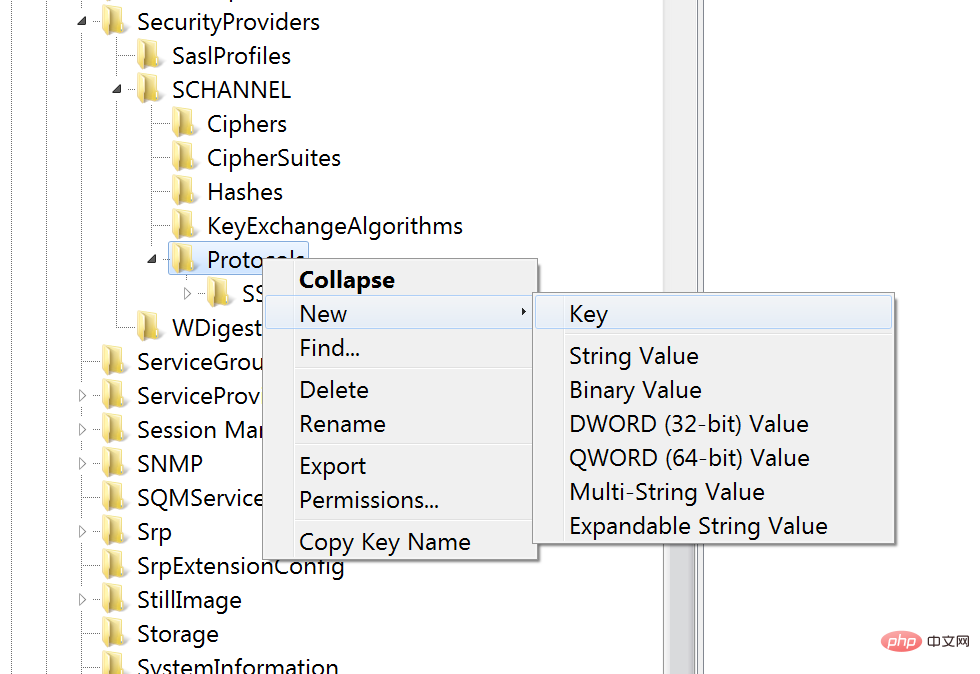Home >Common Problem >3 Ways to Enable TLS 1.2 on All Windows Versions in 2022
3 Ways to Enable TLS 1.2 on All Windows Versions in 2022
- WBOYWBOYWBOYWBOYWBOYWBOYWBOYWBOYWBOYWBOYWBOYWBOYWBforward
- 2023-05-02 11:43:0611493browse
Transport Layer Security (TLS 1.2), also known as Transport Layer Security, is an encryption protocol designed to keep user data secure when it is transmitted over a network. The TLS 1.2 protocol is similar to SSL (Secure Sockets Layer).
Transport Layer Security (TLS 1.2) is used primarily by client-server applications to share data and information across networks without security holes or information leakage.
It provides confidentiality, authenticity, and integrity through the use of certificates between computer applications that share information.
How to check if TLS 1.2 is enabled?
Transport layer security was introduced as an Internet Engineering Task Force in 1999 and has continued to evolve since then, with the introduction of TLS 1.2 in 2008.
Transport layer security has two layers of operations: TLS handshake protocol and TLS records. TLS operations are at the application layer.
TLS 1.2 is more than just an upgrade; it’s an important step to ensure secure data sharing. Older versions of transport layer security have become vulnerable, and security holes can be easily avoided using TLS 1.2.
Make sure to update the TLS version to TLS 1.2. and TLS 1.2. Enable on your system to protect your data.
TSL 1.2 and 1.3 are enabled by default on Windows 11. You can also read this article to learn more about how the protocol works.
The quickest way to check if TLS 1.2 is enabled on your computer is to search for the registry key to see if it exists. HKEY_LOCAL_MACHINE\SYSTEM\CurrentControlSet\Control\SecurityProviders\SCHANNEL\Protocols\TLS 1.2\Client\Enabled and its corresponding value 1.
What is the command to check TLS version in Windows?
- Press Windows X.
- SelectWindows Powershell.

- Enter the following command:
Get-TlsCipherSuite.
- Press Enter. Yes
You can check the version of TLS 1.2 using the following command in Windows: openssl s_client -connect www.google.com:443 -tls1_2. If you get the certificate chain and handshake you will be able to tell if the version is supported. Otherwise, you will receive a handshake error message.
How do you check which TSL protocol is being used?
- Press Windows R.

- Press Enter.
- In the Internet Properties window, click the Advanced tab.

- Scroll to the bottom of the page and check which TLS protocol was viewed.

There are different TLS protocols, the latest is 1.3. You can see which ones are currently in use by noting which checkboxes are selected.
How to enable TLS 1.2 on Windows?
➡ How to enable TLS 1.2 on Windows 11?
- ClickWindows R.

- Press Enter.
- In the Internet Properties window, click the Advanced tab.

- Scroll down and check the TSL protocol in use
 ##Select
##Select - Apply. Close the browser window and restart your Google Chrome browser.
- Open Google Chrome.
- Press
- ALT F. Select
- settings.
 Click
Click - Advanced.
 Scroll down and select
Scroll down and select - System. Click
- to open your computer’s proxy settings. Click
- Internet Options and select Advanced. Scroll down and click
- Security and check the Use TLS 1.2 box.
 Click
Click - OK. Close the browser window and restart the browser.
- Go to the status bar and click the Windows button. Click Run.
- Type
- Regedit in the run page.
 Click OK to access the Registry Editor.
Click OK to access the Registry Editor. - Clicking the
- OK button will give you access to Windows Options For Windows 7, enter this registry key:
-
HKEY_LOCAL_MACHINE\SYSTEM\CurrentControlSet \Control\SecurityProviders\SCHANNEL\Protocols
. Click the "Protocols" folder, click "
Click the "Protocols" folder, click " - New" and select from the drop-down menu Select "Key".
 After completing step 5, a new folder named
After completing step 5, a new folder named - New Key #1 will be created. Rename the folder to TLS 1.2.
- Right-click the TLS 1.2 tab and click
- New. Select a key from the drop-down menu.
- When Step 7 is completed, a new folder named New Key #1 will be created.
- Rename the folder to Client.
-
 Right-click the client key, click
Right-click the client key, click - New, and select a DWORD (32-bit) value from the drop-down list. Click on the DWORD (32-bit) value and a new file named
- "New Value #1". Change the name to Disabled by default.

- After completing all steps, restart the system to activate the changes.
➡ How to enable TLS 1.2 on Windows Server 2019?
- Press the Windows R button to access Regedit.
- Press Enter.
- Navigation
Computer\HKEY_LOCAL_MACHINE\SYSTEM\CurrentControlSet\Control\SecurityProviders\SCHANNEL\ - Right-click the right pane and clickNew.
- Select key.
- Name the new key TLS 1.2 and click on it.
- Click New.
- Create a new key named Client.
- Right-click the client key and click New.
- Select a DWORD (32-bit) value .
- Name the new file DWORD DisabledByDefault.
- Double-click it to open its properties
- Make sure the base is hexadecimal and the value is zero.
- Create another new DWORD file and name it Enabled.
- Double-click it to make sure the base is hexadecimal and the value is one.
- Repeat the same steps for the server key using the exact words: DWORDS and Values.
- Close the registry.
- Restart the system.
➡ How to enable TLS 1.2 on Windows Server 2016?
- First, open the Windows Start menu.
- Type Regedit in the search bar to open it.
- Make sure to back up your current registry before making any changes.
- In the registry, go to
Computer\HKEY_LOCAL_MACHINE\SYSTEM\CurrentControlSet\Control\SecurityProviders\SCHANNEL\Protocols
- Right click on the empty space in the right pane and click New.
- Select key.
- Name the new key TLS 1.2
- Right-click on the empty right pane again and create two new keys named Client and # New key for ##Server. Select the Client key, click
- New, then select a DWORD (32-bit) value. Click on the DWORD and rename it to
- DisabledByDefault. Right click on it, change the base to hexadecimal and set the value to zero.
- Create another
- DWORD and name it enabled. Change the base to
- hex and set the value to one.
- Repeat the same steps for the server key and create DWORDS with the same values. Close the registry and restart your server.
- Start the
- regedit.exe program. Enter path:
- HKEY_LOCAL_MACHINE\SOFTWARE\Microsoft\.NETFramework\v2.0.50727.
- SystemDefaultTlsVersions. Set the DWORD value to
- -. Create another entry named
- SchUseStrongCrypto and set the DWORD value to one. Go to path:
- HKEY_LOCAL_MACHINE\SOFTWARE\Microsoft\.NETFramework\v4.0.30319
.Create an entry and name it - SystemDefaultTlsVersions. Set the DWORD value to
- -. Make the same changes to the 64-bit operating system location:
- HKEY_LOCAL_MACHINE\SOFTWARE\Wow6432Node\Microsoft\.NETFramework\v2.0.50727
.Please create a new entry, And name it - SystemDefaultTlsVersions. Set the DWORD value to
- -. Create another entry and name it
- SchUseStrongCrypto and set the DWORD value to one. Go to
- HKEY_LOCAL_MACHINE\SOFTWARE\Wow6432Node\Microsoft\.NETFramework\v4.0.30319
.Perform the same modifications as in the earlier position.
- Search for
- servers from the top menu bar. From the list of options, select the server of your choice.
- Go to
- Server Management and select Settings and Packages. Click the
- Advanced tab and scroll down to the Nginx box.
- TLS VersionsA list of selected versions will be displayed. Click Edit to make changes. Select the desired protocol as per the requirement and click
- Save changes.
As mentioned previously, TSL 1.3 is automatically enabled on modern Preview builds of Windows. As far as Internet security deployment protocols go, TSL 1.3 is the standard. Its security protocols are formulated in a way to facilitate endpoint-to-endpoint data transfer. That is, it provides an additional layer of security for client-server communication.
The new protocol resolves most of the flaws of the previous version, making the encryption algorithm obsolete. As a result, the handshake protocol (client authentication) is greatly encrypted and enhanced.
In addition, TSL 1.3 has significant privacy improvements. This means that the network's visibility into your user details and information is severely limited.
The above is the detailed content of 3 Ways to Enable TLS 1.2 on All Windows Versions in 2022. For more information, please follow other related articles on the PHP Chinese website!

